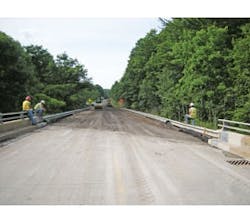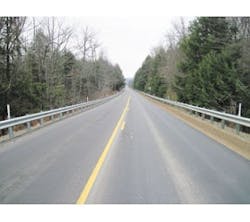Taking down a trampoline
Several of the trees entrenched in the landscape covered by District 2 of the Pennsylvania Department of Transportation (PennDOT) are marked to become a piece of expensive furniture.You can’t find better cherry, maple or oak wood anywhere else in the U.S. Unfortunately the roads which service the coffee tables and couches of the future have been keeping PennDOT officials on the edge of their state-issued seats for years now.
Many of the district routes started out as gravel roads decades ago, and have been paved over many times. The problem starts at the base, which in many cases was never fully stabilized and succumbs to the negative effect of the glacial till in the area every fall and spring.
“When the thaw comes out of the ground the substructure just turns into mush and it’s like walking on a trampoline,” Dave Mader, maintenance program engineer for PennDOT District 2, told Roads & Bridges. “You are sinking everywhere you go.”
And the industry demand taxing the area continues to rise. The calling from the furniture business keeps timber rolling through the green, hilly terrain, and there also are a number of conventional oil and gas wells and Marcellus shale drilling operations in place. Tourism also has its season.
In order to satisfy consumers, trucks make the old, beaten pavement groan on every pass, and it has become just too much to bear. With road maintenance budgets shrinking, PennDOT was forced to put a 10-ton weight restriction on most of the pathways. Up until recently, the method of repair was expensive mill-and-fill patches which did not carry a long service life. Then Pennsylvania passed Act 89, and routes like S.R. 321 finally had a place on the construction schedule.
“When funding became available a portion of the new Act 89 money was allotted to remove postings off of roads,” said Mader, “and they had to be the absolute worst-case roads, and we were lucky enough that [S.R. 321] fit the equation very well.”
Only the absolute best win the Roads & Bridges/Asphalt Recycling and Reclaiming Association Recycling Awards, and the challenges that were met with full-depth reclamation in the thick Allegheny National Forest, as well as a total savings of $600,000 due to recycling efforts, made the S.R. 321 project an easy pick.
S.R. 321 was holding up fairly well despite the truck traffic created by the timber and oil and gas exlporation industries. When the Marcellus shale boom hit the area, it reached a breaking point.
Losing a coat,
adding a snowshoe
Prior to 2010, S.R. 321 took on the appearance of your typical rural, two-lane road in Pennsylvania. Sure it was showing it’s age and had a number of different pavement-maintenance treatments on it, but for the most part the route was holding up against the timber, oil and gas exploration and recreation traffic. When the Marcellus shale industry staked it’s claim, a 19-mile stretch of S.R. 321 reached the ultimate breaking point.
“The Marcellus shale boom hit our area and we were really forced to post a lot of roads like this one,” said Mader.
“The whole road had a series of seal coat treatments, and when we have pavement that reaches the end of its useful life we will seal coat those types of roads because we didn’t have the budget to repave. This road was being seal-coated every 2 to 4 years so we could just try to hold it together,” Peter Kempf, PennDOT District 2 posted and bonded roads coordinator, told Roads & Bridges.
Conditions were so bad a shale company took the initiative and upgraded a small portion of S.R. 321 with FDR and an asphalt overlay in July 2013. The state of Pennsylvania, PennDOT District 2 and the U.S. Department of Agriculture Forest Service had a 3.3-mile portion of S.R. 321 in the design phase. The project would include widening, base repair, milling and the application of a variable depth binder and bituminous overlay.
The passage of Act 89 and the idea of using FDR created new opportunities. PennDOT District 2 also wanted to take care of a 13-mile portion of S.R. 321, adjacent to the 3.3-mile section under design, that would be executed using the full-depth repair method.
“It just so happened that the two projects coincided about the same time [when Act 89 passed] and they were setting up identical letting dates to encourage the successful bidder to win both projects,” said Mader. “Then after the project was bid and the same company got both jobs and started looking at the road conditions it became a no-brainer to modify the federal project into the same treatment that we were doing on the other portion being funded by Act 89.”
IA Construction Corp. and Base Construction Technologies formed the winning construction team. PennDOT consulted with designer URS Corp. and the recommendation was to go with a 12-in. full-depth reclamation chemical stabilization utilizing 4.5% portland cement by dry weight (or approximately 48 lb per sq yd), a 3-in. bituminous binder and a 1.5-in. wearing course. Construction started in mid-June 2014 and was finished less than five months later.
Perhaps the most critical aspect of the job came before any of the heavy machinery had a chance to breathe in the fresh Allegheny air. Extensive surveying was done to guide the contractor through the project. Stakes were set 16 ft off of the centerline of the road.
“I like to set an even offset on the entire length of the road if possible and if we can’t do a constant offset [like on S.R. 321] we will do two offsets . . . but we will set those at 100 ft and will set all of the super elevations in the field with the contractor to transition in and out of the supers,” Jason Snyder, principal engineer at URS, told Roads & Bridges.
Two sets of Wirtgen WR2500S reclaimers were used on S.R. 321. The first tandem went out and chewed up the entire roadbed and subgrade together. Following those machines was a Caterpillar CP563 padfoot compactor, a John Deere 672 CH II motor grader and a Caterpillar CS56 smooth drum compactor. The second set of Wirtgen WR2500S reclaimers helped execute the stabilization operation, which followed the pulverization process. The duo mixed in the cement, which was applied in front of the operation, and the padfoot compactor, motor grader and smooth drum compactor followed to make sure the proper density was achieved. Three to five days were allowed for curing, but S.R. 321 was opened up immediately to light traffic.
Moisture content and density were monitored during the FDR process. Moisture content was checked at the start of each workday, and if the reclaimer operator noticed a change it would be checked again. The density target was 98%, and a test strip was used in the morning. After the initial reading a density meter was used to monitor the process every 200 ft.
Crews came in later to apply the 3-in. bituminous binder and 1.5-in. wearing course. A Roadtec SB2500 Shuttle Buggy was used to ensure smoothness on the wearing course mat. The Shuttle Buggy fed a Caterpillar AP1055D asphalt paver. A Caterpillar CB54 vibratory roller, a Caterpillar PS-150C rubber-tire roller and a Bomag BW11AS finish roller handled the compaction duties. The asphalt mix contained a PG 58-28 binder and the aggregate size ranged from No. 200 to ½ in.
The true benefits of FDR will be seen this spring during the thaw. No longer is there just an asphalt pavement sitting on aggregate. The cement blended in during the FDR process provides a semi-rigid 12-in.-thick section.
“The FDR acts essentially as a snowshoe; basically a big slab,” said Snyder. “It’s no longer subgrade material, it is now part of the paving section. This road has a 17-in. paving section on it which dissipates the load until it gets down in the glacial tills.”
Everything was recycled on this project, which eliminated a substantial amount of truck haul trips in and out of this remote location.
“We landfilled nothing,” noted Snyder. “We recycled 100% of everything in the existing roadway. We use it for shoulder back up; we re-use everything. It’s less stress on the surrounding area, and it’s fast.”
The true benefits of FDR will be seen this spring during the thaw. No longer is there just an asphalt pavement sitting on aggregate. The cement blended in during the FDR process provides a semi-rigid 12-in.-thick section.
More work to be done
It’s fast and it is apparently here to stay in the PennDOT District 2 region. A bigger project funded by Act 89 is planned in Potter County on S.R. 44 and S.R. 144 in 2015. Crews will do a LiDAR survey of S.R. 44 for quicker and more accurate results.
The current road also has a 10-ton weight restriction, and a local shale company spent $2 million on mill-and-fill operations over a two-year period before deciding to move operations because the road is in such poor condition.
“It ended up being a huge waste of money in their eyes because all they were doing was putting in a new patch and 10 ft away a new area would fail,” said Kempf. R&B


